We’re already in Q4, and I can’t believe how quickly this year has gone. Q1 is already around the corner.
Therefore, if you want to end your 2023 with a bang, you need a plan.
However, this quarterly checkup isn’t just for the end of the year. I recommend using this process at the end of every quarter to reset your business, refresh your goals, and tackle the next 90 days.
Why is it important?
Quarterly resets are more than an overview of your business. They’re also a way to create a plan and set your intentions for the next stage of your business.
They also let you realign your business, ensure it’s growing in the right direction, reevaluate your goals, and find any cracks or flaws that need tending to.
And you can do it all in three easy stages.
Stage 1: Reflect
Take a moment to reflect on the last 90 days and ask yourself:
- How did they go?
- What could be improved?
- What is an accomplishment that you’re proud of?
- What is a roadblock that you encountered?
- What is your intention for the next 90 days?
Once you have the answers, write them down and remember them for the next stage.
Stage 2: Plan
With those reflections in mind, ask yourself the following:
- What is one thing you want to accomplish in the next three months?
- What is one thing that will move the needle forward in your business?
- Finally, is there something you’ve avoided that you need to do?
It’s okay to create a goal that will take two to three months to complete but remember to break it down into KPIs. For example, let’s say you want to launch a new service. Your plan may look like this:
Month 1:
- Refine the offer
- Become clear on the service
Month 2:
- Finish the processes
- Content KPI
- Send to first beta testers
- Engagement KPI
- User KPI
Month 3:
- Test launch the service
- Marketing KPI
- Marketing goals
- Fix any flaws or hang-ups
Or, maybe you’re building a course. In that case, it might get broken down like this:
Month 1:
- Perfect the idea
- Create the content
Month 2:
- Create a launch strategy
- Marketing KPI
- Marketing goal
- Finish building the course
- Content KPI
- Content goal
Month 3:
- Send to beta testers
- User KPI
- Full Launch
- Engagement KPI
- Weekly goal
Either way, you have your long-term goals (monthly) and shorter KPIs (weekly reports or goals). By combining them, you have a plan that is simple yet powerful.
Stage 3: Accountability
Accountability is the hardest part of any plan, but you can make your intentions a success with some help.
Firstly, put your plan where you can see it EVERY DAY. On the fridge, by the bathroom mirror, on your door, stuck to your monitor- anywhere. That way, you’re always aware of your goals and can remind yourself to do one thing a day that gets you closer to the finish line.
However, if you need a firmer hand, tell a friend or family member about your goals and have them check in with you every week. Have them ask you about your progress and remind you why you set this goal in the first place. Then, you’ll never be far from the encouragement you need to succeed.
Another way to hold yourself accountable is to put your plan into your task management software, set a deadline for the KPIs and goals, and set reminders to keep yourself (and your team) on track.
It’s a business task like any other, so why not treat it like one?
Final Thoughts
Quarterly resets are more than an end-of-year process. They offer us an opportunity to realign our business goals, reset our intentions, and create a plan to tackle the next quarter.
And remember- it’s okay for your goals and priorities to change, but you shouldn’t stop working on them. Instead, use this process at the end of every quarter to seamlessly adjust your plan and add your new goals.
By using quarterly resets, you’ll see a major shift in the intention and success of your business. Are you ready for it?







